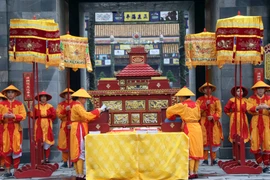Tang Tho Lau, built in 1825 under the reign ofKing Minh Mang (1791 – 1841), is a two-storey building located on a rectangularislet at the centre of Hoc Hai Lake.
It is divided into small spaces with manywindows, and this scientific design is meant to serve the function of storingand conserving books and important papers of the court.
The Hue Monuments Conservation Centre said TangTho Lau used to suffer from serious degradation due to ups and downs in historywhile archives kept here had been displaced, even to other countries.
After Tang Tho Lau was put under the centre’smanagement, its restoration has been carried out since 2014, and the site iscurrently storing a large number of documents, videos, and images.
Director of the conservation centre Vo Le Nhatexpressed his hope that in the time ahead, Tang Tho Lau will not only be aplace for keeping archives or studying cultural heritage but also become a uniqueattraction for both researchers and tourists.
The Complex of Hue Monuments was recognised as aworld cultural heritage site by UNESCO in 1993.
Apart from this complex, Hue city, which was theimperial capital of Vietnam during the Nguyen Dynasty, is also home to fourothers in the world heritage lists, namely “Nha nhac” or Vietnamese court music(Intangible Cultural Heritage of Humanity); the woodblocks of theNguyen Dynasty (part of the Memory of the World Programme); the imperial archivesof the Nguyen Dynasty (part of the Memory of the World Programme); and theLiterature on Hue Royal Architecture (part of DocumentaryHeritage in the Memory of the World Programme)./.






























